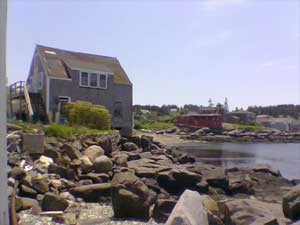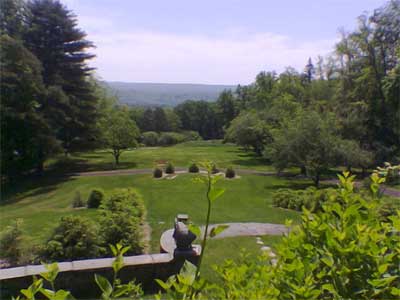On The Green Road: Wanted: Seal Instructor for Environmental Education
Friday, August 29th, 2008About the Author: Dr. Dale Haroski is the science advisor to the Office of Public Affairs where she translates science for the public, and more recently, has begun exploring marine mammal outreach opportunities. As a new hobby, she enjoys pointing and yelling “SEAL!” when her fiancé ventures near any type of water.
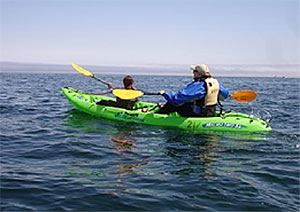 We had our wetsuits. We had our paddles. We were ready. “One last thing,” said our perky kayaking instructor. “The Marine Mammal Protection Act requires that you stay 100 feet away from any marine mammals so don’t approach any closer than that. They can be inquisitive, however, so if they approach you just remain quiet, avoid eye contact, and they will eventually leave.” Ok. No problem. Avoid marine mammals. Let’s paddle.
We had our wetsuits. We had our paddles. We were ready. “One last thing,” said our perky kayaking instructor. “The Marine Mammal Protection Act requires that you stay 100 feet away from any marine mammals so don’t approach any closer than that. They can be inquisitive, however, so if they approach you just remain quiet, avoid eye contact, and they will eventually leave.” Ok. No problem. Avoid marine mammals. Let’s paddle.
On a recent family vacation to California my fiancé (also an EPA employee) and I decided to take his eight-year-old daughter kayaking in Monterey Bay. His daughter and I quickly set out in our two person kayak and charted a course for the kelp forest.
 Soon, we spotted a harbor seal attempting to climb onto a small piece of driftwood. “Aw look! A little seal!” we sighed as it disappeared from sight. Then, out of nowhere, the little seal head popped up directly next to me and peered at me with those big soulful eyes. “OOOHHHH LOOOOK!!!!!” I squealed in a high pitch normally reserved for puppy and kitten sightings. “It’s right here! It’s soooo cute!” I shouted to no one in particular. He circled around us a few times and disappeared once again.
Soon, we spotted a harbor seal attempting to climb onto a small piece of driftwood. “Aw look! A little seal!” we sighed as it disappeared from sight. Then, out of nowhere, the little seal head popped up directly next to me and peered at me with those big soulful eyes. “OOOHHHH LOOOOK!!!!!” I squealed in a high pitch normally reserved for puppy and kitten sightings. “It’s right here! It’s soooo cute!” I shouted to no one in particular. He circled around us a few times and disappeared once again.
My fiancé started to put away his camera when the little guy popped up behind his kayak. “He’s behind you!” we yelled! Then, right before our stunned eyes, the little seal jettisoned himself out of the water and attempted to haul out onto the back of my fiancé’s kayak! We howled with laughter at my fiancé’s panic as his kayak rolled from side to side. The seal soon gave up and we breathed a sigh of relief while wiping away the tears of laughter.
Just when we thought it was safe two little eyes popped up again behind his kayak. “PADDLE HONEY PAAAADDDDDLLLLLE!” I shouted, thinking that a moving target would be harder to hit. Scenes of Jaws flitted through my head. Finally the little seal gave up and all I could think was “Great. I can see the headlines now: EPA employees found in violation of the Marine Mammal Protection Act.” It wasn’t our fault officer, really!
Kayaking was enjoyable after that but it made me realize that environmental regulations really only work if people know about them and follow them. Now if only someone could educate the marine mammals we’d be all set.

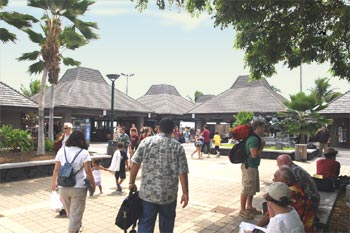
 The other thing I wanted to mention is the coqui frog. You may remember
The other thing I wanted to mention is the coqui frog. You may remember 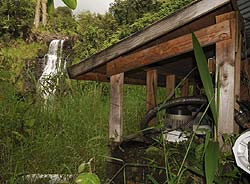 But this place isn’t special just because of the waterfall. The natural beauty is matched by how the Suttons manage the place. Len built his own small hydroelectric plant that supplies all of their electricity, working extensively with state biologists and the Hawaii Dept. of Land and Natural Resources. Their roof catches rain and sends it to a treatment system. And soon, they’ll be composting and growing some of their own food. Basically, their goal is to have a negative
But this place isn’t special just because of the waterfall. The natural beauty is matched by how the Suttons manage the place. Len built his own small hydroelectric plant that supplies all of their electricity, working extensively with state biologists and the Hawaii Dept. of Land and Natural Resources. Their roof catches rain and sends it to a treatment system. And soon, they’ll be composting and growing some of their own food. Basically, their goal is to have a negative  Several years ago, I worked for the
Several years ago, I worked for the 